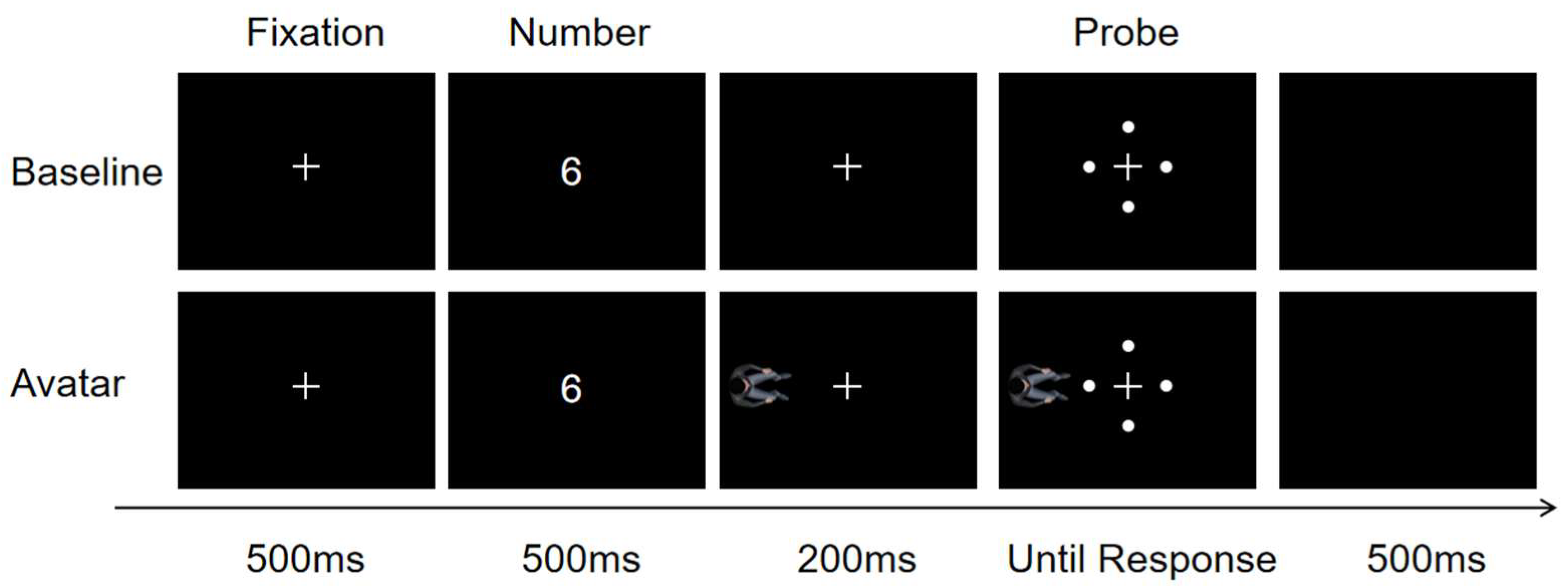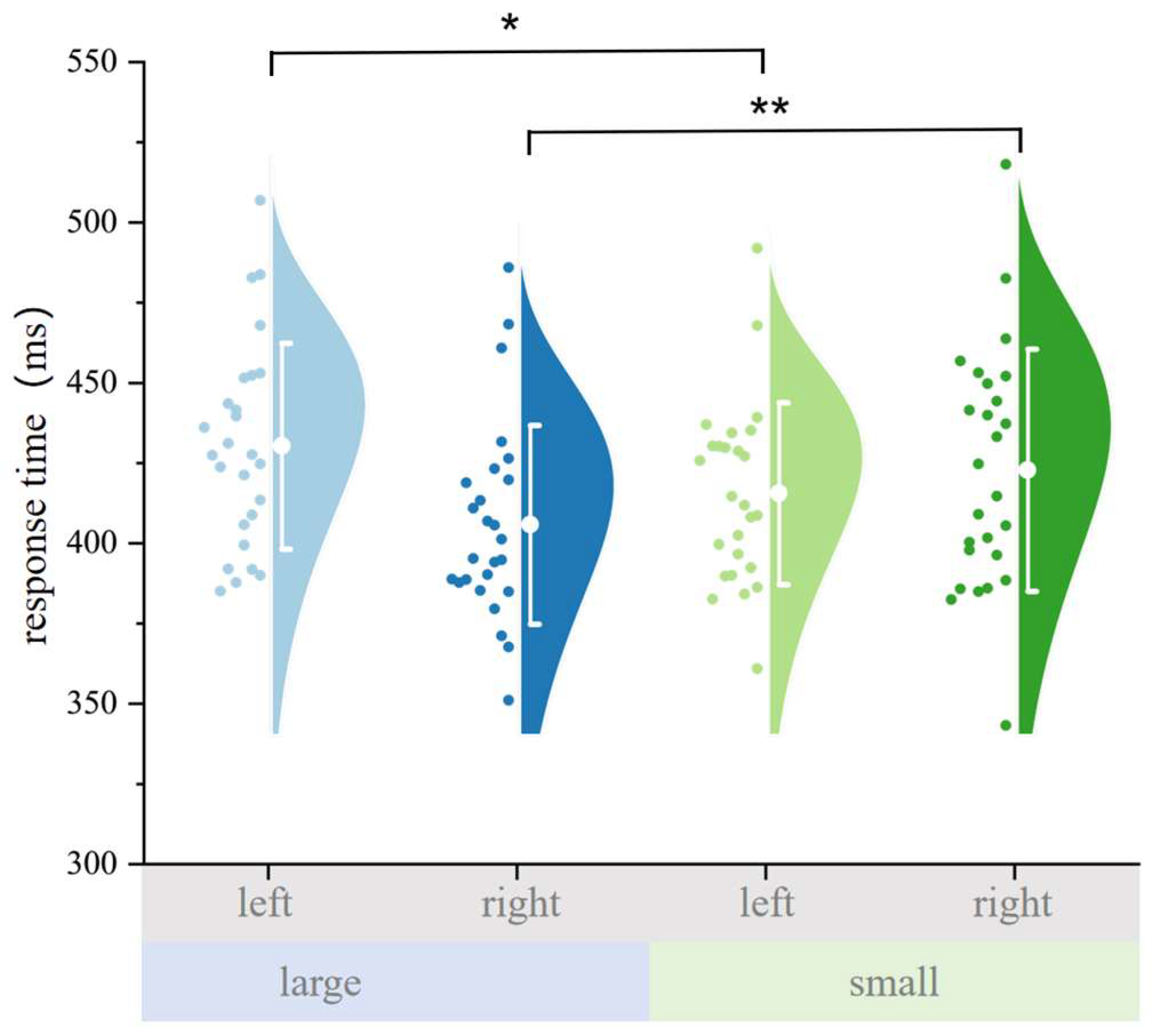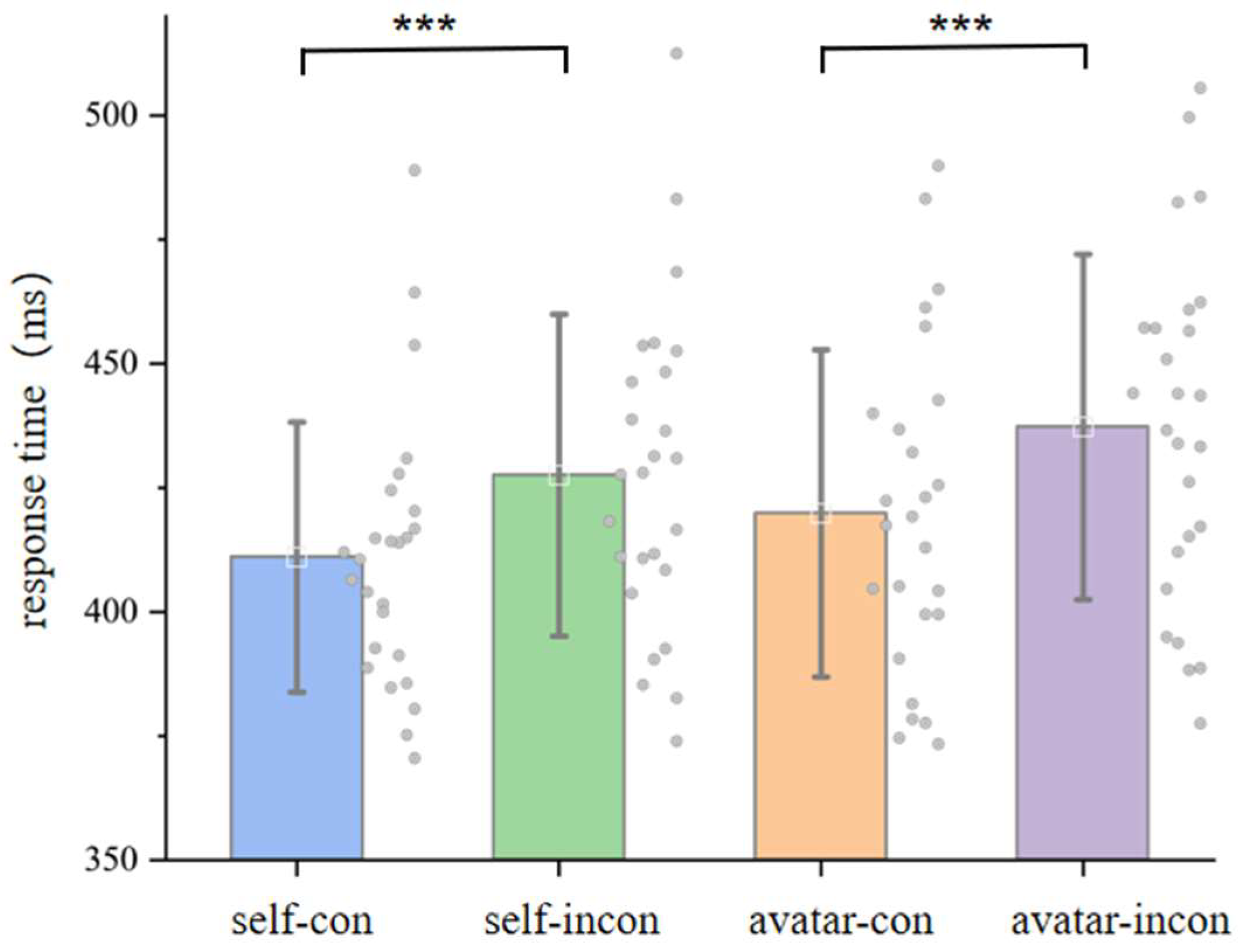Through Another’s Eyes: Implicit SNARC-like Attention Bias Reveals Allocentric Mapping of Numerical Magnitude
Abstract
1. Introduction
2. Materials and Methods
2.1. Participants
2.2. Materials and Stimuli
2.3. Design and Procedure
2.4. Data Recording
2.5. Data Analysis
3. Results
3.1. Preliminary Check: Response Key Bias
3.2. Egocentric Digit-Based Attentional Orientation
3.3. Allocentric Digit-Based Attentional Orientation
4. Discussion
4.1. Egocentric SNARC-like Effect and Its Spatial Characteristics
4.2. Avatar-Induced Allocentric Mapping: Evidence for Embodied Perspective Taking
4.3. Reference Frame Flexibility and Socially Contingent Embodiment
4.4. Theoretical and Methodological Contributions
4.5. Limitations and Future Directions
5. Conclusions
Funding
Institutional Review Board Statement
Informed Consent Statement
Data Availability Statement
Acknowledgments
Conflicts of Interest
References
- Atmaca, S., Sebanz, N., Prinz, W., & Knoblich, G. (2008). Action co-representation: The joint SNARC effect. Social Neuroscience, 3(3–4), 410–420. [Google Scholar] [CrossRef]
- Avraamides, M. N., Loomis, J. M., Klatzky, R. L., & Golledge, R. G. (2004). Functional equivalence of spatial representations derived from vision and language: Evidence from allocentric judgments. Journal of Experimental Psychology: Learning, Memory, and Cognition, 30(4), 801. [Google Scholar]
- Böffel, C., Herbst, C., Lindemann, O., & Müsseler, J. (2021). Spatial–numerical associations in the presence of an avatar. Psychological Research, 85(7), 2588–2598. [Google Scholar] [CrossRef]
- Böffel, C., & Müsseler, J. (2019). Action effect consistency and body ownership in the avatar-Simon task. PLoS ONE, 14(8), e0220817. [Google Scholar] [CrossRef] [PubMed]
- Bukowski, H., Hietanen, J. K., & Samson, D. (2015). From gaze cueing to perspective taking: Revisiting the claim that we automatically compute where or what other people are looking at. Visual Cognition, 23(8), 1020–1042. [Google Scholar] [CrossRef] [PubMed]
- D’Ascenzo, S., Fischer, M. H., Shaki, S., & Lugli, L. (2022). Number to me, space to you: Joint representation of spatial-numerical associations. Psychonomic Bulletin & Review, 29(2), 485–491. [Google Scholar]
- de Hevia, M. D., Girelli, L., & Vallar, G. (2008). Numbers and space: A cognitive illusion? Experimental Brain Research, 188(3), 551–556. [Google Scholar]
- Ekstrom, A. D., & Isham, E. A. (2017). Human spatial navigation: Representations across dimensions and scales. Current Opinion in Behavioral Sciences, 17, 84–89. [Google Scholar] [CrossRef]
- Fias, W., & Fischer, M. H. (2005). Spatial representation of numbers. In The handbook of mathematical cognition (pp. 43–54). Psychology Press. [Google Scholar]
- Fischer, M. H., & Coello, Y. (Eds.). (2016). Conceptual and interactive embodiment. Routledge. [Google Scholar]
- Furlanetto, T., Becchio, C., Samson, D., & Apperly, I. (2016). Altercentric interference in level 1 visual perspective taking reflects the ascription of mental states, not submentalizing. Journal of Experimental Psychology: Human Perception and Performance, 42(2), 158. [Google Scholar] [CrossRef]
- Gevers, W., & Lammertyn, J. (2005). The hunt for SNARC. Psychology Science, 47(1), 10–21. [Google Scholar]
- Gevers, W., Reynvoet, B., & Fias, W. (2006). The mental representation of ordinal sequences is spatially organized. Cognition, 91(2), 145–155. [Google Scholar] [CrossRef] [PubMed]
- Guo, G., Wang, N., Sun, C., & Geng, H. (2024). Embodied cross-modal interactions based on an altercentric reference frame. Brain Sciences, 14(4), 314. [Google Scholar] [CrossRef]
- Kampis, D., & Southgate, V. (2020). Altercentric cognition: How others influence our cognitive processing. Trends in Cognitive Sciences, 24(11), 945–959. [Google Scholar] [CrossRef]
- Kessler, K., & Rutherford, H. (2010). The two forms of visuo-spatial perspective taking are differently embodied and subserve different spatial prepositions. Frontiers in Psychology, 1, 213. [Google Scholar] [CrossRef]
- Kessler, K., & Thomson, L. A. (2010). The embodied nature of spatial perspective taking: Embodied transformation versus sensorimotor interference. Cognition, 114(1), 72–88. [Google Scholar] [CrossRef]
- Lakoff, G., & Núñez, R. (2000). Where mathematics comes from: How the embodied mind brings mathematics into being. Basic Books. [Google Scholar]
- Leibovich, T., Katzin, N., Harel, M., & Henik, A. (2017). From “sense of number” to “sense of magnitude”: The role of continuous magnitudes in numerical cognition. Behavioral and Brain Sciences, 40, e164. [Google Scholar] [CrossRef]
- Michelon, P., & Zacks, J. M. (2006). Two kinds of visual perspective taking. Perception & Psychophysics, 68(2), 327–337. [Google Scholar] [CrossRef]
- Moorkens, J., van Dijck, J. P., & Fias, W. (2025). The parity judgment SNARC effect: The role of response mapping order and the nature of the instruction. Journal of Numerical Cognition, 11, 1–12. [Google Scholar] [CrossRef]
- Müsseler, J., Ruhland, L., & Böffel, C. (2019). Reversed effect of spatial compatibility when taking avatar’s perspective. Quarterly Journal of Experimental Psychology, 72(6), 1539–1549. [Google Scholar] [CrossRef]
- Müsseler, J., von Salm-Hoogstraeten, S., & Böffel, C. (2022). Perspective taking and avatar-self merging. Frontiers in Psychology, 13, 714464. [Google Scholar] [CrossRef] [PubMed]
- Proctor, R. W., & Cho, Y. S. (2006). Polarity correspondence: A general principle for performance of speeded binary classification tasks. Psychological Bulletin, 132(3), 416. [Google Scholar] [CrossRef]
- Roth, L., Caffier, J., Reips, U. D., Nuerk, H. C., Overlander, A. T., & Cipora, K. (2025). One and only SNARC? spatial-numerical associations are not fully flexible and depend on both relative and absolute number magnitude. Royal Society Open Science, 12(1), 241585. [Google Scholar] [CrossRef]
- Rugani, R., Vallortigara, G., Priftis, K., & Regolin, L. (2015). Number-space mapping in the newborn chick resembles humans’ mental number line. Science, 347(6221), 534–536. [Google Scholar] [CrossRef]
- Samson, D., Apperly, I. A., Braithwaite, J. J., Andrews, B. J., & Bodley Scott, S. E. (2010). Seeing it their way: Evidence for rapid and involuntary computation of what other people see. Journal of Experimental Psychology: Human Perception and Performance, 36(5), 1255–1266. [Google Scholar] [CrossRef]
- Saxe, G. B., Guberman, S. R., Gearhart, M., Gelman, R., Massey, C. M., & Rogoff, B. (1987). Social processes in early number development. Monographs of the Society for Research in Child Development, 52, i–162. [Google Scholar] [CrossRef]
- Schwarz, W., & Keus, I. M. (2004). Moving the eyes along the mental number line: Comparing SNARC effects with saccadic and manual responses. Perception & Psychophysics, 66, 651–664. [Google Scholar] [CrossRef]
- Shaki, S., & Fischer, M. H. (2018). Deconstructing spatial–numerical associations. Cognition, 175, 109–113. [Google Scholar] [CrossRef] [PubMed]
- Shaki, S., Fischer, M. H., & Petrusic, W. M. (2009). Reading habits for both words and numbers contribute to the SNARC effect. Psychonomic Bulletin & Review, 16(2), 328–331. [Google Scholar] [CrossRef] [PubMed]
- Simpson, A. J., & Todd, A. R. (2017). Intergroup visual perspective-taking: Shared group membership impairs self-perspective inhibition but may facilitate perspective calculation. Cognition, 166, 371–381. [Google Scholar] [CrossRef]
- Surtees, A. D. R., Apperly, I. A., & Samson, D. (2013). The use of embodied self-rotation for visual and spatial perspective-taking. Frontiers in Human Neuroscience, 7, 698. [Google Scholar] [CrossRef] [PubMed]
- Tversky, B., & Hard, B. M. (2009). Embodied and disembodied cognition: Spatial perspective-taking. Cognition, 110(1), 124–129. [Google Scholar] [CrossRef] [PubMed]
- Tzelgov, J., Zohar-Shai, B., & Nuerk, H. C. (2013). On defining quantifying and measuring the SNARC effect. Frontiers in Psychology, 4, 302. [Google Scholar] [CrossRef]
- Wang, C., Chen, X., & Knierim, J. J. (2020). Egocentric and allocentric representations of space in the rodent brain. Current Opinion in Neurobiology, 60, 12–20. [Google Scholar] [CrossRef]
- Wang, R. F., & Spelke, E. S. (2002). Human spatial representation: Insights from animals. Trends in Cognitive Sciences, 6(9), 376–382. [Google Scholar] [CrossRef]
- Ward, E., Ganis, G., & Bach, P. (2019). Spontaneous vicarious perception of the content of another’s visual perspective. Current Biology, 29(5), 874–880. [Google Scholar] [CrossRef]
- Ward, E., Ganis, G., McDonough, K. L., & Bach, P. (2020). Perspective taking as virtual navigation? Perceptual simulation of what others see reflects their location in space but not their gaze. Cognition, 199, 104241. [Google Scholar] [CrossRef]
- Ward, E., Ganis, G., McDonough, K. L., & Bach, P. (2022). Is implicit Level-2 visual perspective-taking embodied? Spontaneous perceptual simulation of others’ perspectives is not impaired by motor restriction. Quarterly Journal of Experimental Psychology, 75(7), 1244–1258. [Google Scholar] [CrossRef] [PubMed]
- Winter, B., Matlock, T., Shaki, S., & Fischer, M. H. (2015). Mental number space in three dimensions. Neuroscience & Biobehavioral Reviews, 57, 209–219. [Google Scholar] [CrossRef] [PubMed]
- Yan, L., Yang, G., Nan, W., Liu, X., & Fu, S. (2021). The SNARC effect occurs in the response-selection stage. Acta Psychologica, 215, 103292. [Google Scholar] [CrossRef]




| Trial Types | Numerical Magnitude | Probe Location |
|---|---|---|
| Self-consistent | Small | Left |
| Large | Right | |
| Self-inconsistent | Small | Right |
| Large | Left | |
| Avatar-consistent | Small | Up |
| Large | Down | |
| Avatar-inconsistent | Small | Down |
| Large | Up |
Disclaimer/Publisher’s Note: The statements, opinions and data contained in all publications are solely those of the individual author(s) and contributor(s) and not of MDPI and/or the editor(s). MDPI and/or the editor(s) disclaim responsibility for any injury to people or property resulting from any ideas, methods, instructions or products referred to in the content. |
© 2025 by the author. Licensee MDPI, Basel, Switzerland. This article is an open access article distributed under the terms and conditions of the Creative Commons Attribution (CC BY) license (https://creativecommons.org/licenses/by/4.0/).
Share and Cite
Luo, W. Through Another’s Eyes: Implicit SNARC-like Attention Bias Reveals Allocentric Mapping of Numerical Magnitude. Behav. Sci. 2025, 15, 1114. https://doi.org/10.3390/bs15081114
Luo W. Through Another’s Eyes: Implicit SNARC-like Attention Bias Reveals Allocentric Mapping of Numerical Magnitude. Behavioral Sciences. 2025; 15(8):1114. https://doi.org/10.3390/bs15081114
Chicago/Turabian StyleLuo, Wanying. 2025. "Through Another’s Eyes: Implicit SNARC-like Attention Bias Reveals Allocentric Mapping of Numerical Magnitude" Behavioral Sciences 15, no. 8: 1114. https://doi.org/10.3390/bs15081114
APA StyleLuo, W. (2025). Through Another’s Eyes: Implicit SNARC-like Attention Bias Reveals Allocentric Mapping of Numerical Magnitude. Behavioral Sciences, 15(8), 1114. https://doi.org/10.3390/bs15081114





